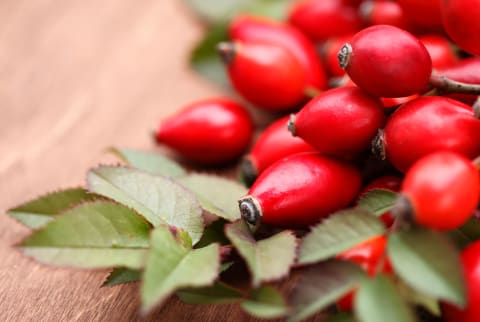Advertisement
This Underrated Fruit Is Packed With Vitamin C (And A+ For Immune Health)


Roses are one of the most popular flowers in the world, but their fruit—called the "hip"—is rarely seen by comparison.
This is unfortunate, because rose hips are bursting with beneficial vitamin C, and they ripen at the perfect time of year to bolster your immune system1 as we head into autumn.
Let's broaden the knowledge and use of this underrated fruit, starting with some stats on why it's a fabulous food-derived source of vitamin C.
Why rose hips are a fabulous source of whole-food vitamin C
Rose hips are one of the highest plant sources of vitamin C. Rose hips from the "dog rose" species (Rosa canina) were made into a syrup to prevent scurvy during World War II and appeared in medical and scholarly texts in Tibet, Persia, and Mediterranean cultures for centuries before that.
Based on a nutritional profile of the fruit from theU.S. Department of Agriculture, a teaspoon of rose hips has more than 11 milligrams of vitamin C, and 2 heaping tablespoons will get you to the recommended dietary allowance for women: 75 mg.
Research suggests that the variety2 of vitamins, minerals, and phytochemicals in whole-food vitamin C sources is important for balanced absorption and integration in the body. In addition to vitamin C, rose hips contain vitamins A, B-3 (niacin), and E and minerals including copper, magnesium, and zinc.
Finally, the flavonoids in rose hips have anti-inflammatory properties that support a healthy gut microbiome3 and help protect the gastrointestinal tract from irritation caused by everyday encounters with synthetic chemicals.
Getting rose hips onto your plate and into your life
Rose hips are tart and slightly sweet, a pleasant flavor that's easy to add as a garnish to other dishes.
At my house, powdered rose hips have a permanent spot on the table, so they're in easy reach when we want to brighten the flavor of a dish. I make it a point to sprinkle them on rice and scrambled eggs. And the sweet-tart combination of rose hip honey (made by mixing rose hip powder into honey) is a divine treat straight from nature. We keep it on hand to use for baking or to drizzle on top of pancakes (and the occasional spoonful on its own).
In cooking, rose hips can be treated much like other small, tart fruits. It's used in jams, syrups, vinaigrettes, and muffins, often accompanied by apple—another fruit from the rose family. When cooking with rose hips, avoid stewing for long periods, as heat destroys vitamin C.
Rose hip tea recipe
This simple rose hip tea is easy to prepare and a warming way to bring rose hips into your day as autumn and winter approach.
Ingredients
- 1 tablespoon dried rose hips
- 1 cup water
Method
- Boil the water.
- Remove from heat and pour over rose hips.
- Let steep 5 to 10 minutes.
- Strain rosehips.
- Pour and enjoy.
The takeaway
Full of flavor and nutrients, rose hips are especially noteworthy as a source of food-based vitamin C. While there are many ways to weave rose hips into your daily food choices, this simple rose hip tea is a lovely way to do so and can be a warming, healthful ritual in cooler months.